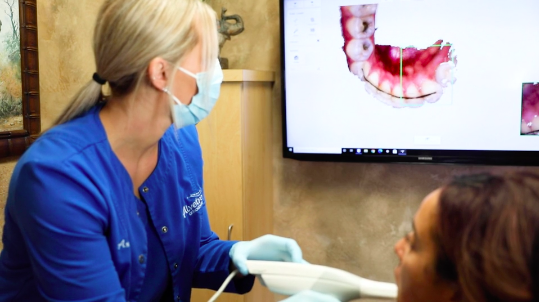Intraoral Scanners
Intraoral scanners are medical devices that create a virtual surface that represents the dental and gingival anatomy of the patient. Intraoral scanners offer many clinical advantages over dental impressions, including: No need for uncomfortable conventional dental impression procedures. No need for pouring the impressions. Detail can be refined while scanning patients, this is an adaptive process and clinicians do not have to wait until after an impression is poured and set to detect errors. No gingival displacement occurs during scanning as opposed to impression. Currently scan times are around 5 minutes which is faster than conventional impression, pouring and setting times. Digital scans can be directly sent to the laboratory, the patient or other professionals. No need for physical storage, and digital impressions are easy to retrieve.
Evaluation Criteria
AAO’s Committee on Technology (CTECH) recommends using the following criteria to evaluate intraoral scanners.
Initial costs:
Verify if the scanner computer is included in the price, or if you need to purchase one separately. Evaluate if software to manipulate models is part of the purchase, or if additional software is required (i.e., “outcome simulators” are normally included in the software package, but tooth movement software is not). Battery backups are also especially important for cart-style scanners, as they can prevent accidental data loss.
Ongoing costs:
Scanner tips are the most significant ongoing cost, check to see if your scanner is compatible with individual or autoclavable tips. Individual use tips cost about $3 each and autoclavable tips costs $40 each and can be used for 75-100 scans per tip when properly sterilized.
Scan time:
Be sure to compare time for a full-arch intraoral scan. AAO CTECH has set 5 minutes as the maximum time to be considered for TechSelect.
Ability to export STL files:
STL files are important for compatibility with the widest range of software and hardware. AAO CTECH requires this ability for inclusion on TechSelect.
Size and footprint:
The scanner and computer can be integrated into one unit with its own wheels, or the scanner and attached computer may also be house separately.
Wand size:
Ensure you select a scanner that gives you the flexibility you need to treat a range of patients. Smaller wands enable you to treat young children, particularly when scanning the retromolar area.
Monochrome or color scans:
STL files are monochrome, so color is not critical for appliance fabrication. However, color can be a nice option for use in patient records or case presentation.
Wired or wireless wand:
Wireless wands can be more convenient and comfortable to use. Wireless scanners may be more expensive.
Multiple occlusal registrations:
Current scanners capture patient’s occlusion by scanning independently the right side and the left side of the patient in occlusion. The digital dental arches are then registered – surface-to-surface – by translating and rotating the digital dental arches into a position and orientation that corresponds with the occlusion of the patients, which is important to evaluate if the scanner and software allows for more than one occlusal registration of the patient’s digital models.
Data storage location:
Scans or digital models are stored either in the computer, in the cloud or both. Cloud storage can come with a cost, but does offer advantages including the ability to process from any computer on the network, freedom to access scans from anywhere and flexibility for other professionals to handle different steps of the process.
Data export process:
To print digital models, the scanner’s proprietary files need to be converted to a standard format (STL or OBJ files). These files are then loaded into the lab databased software or directly to the 3D printer). Most manufacturers charge a “fee per export” for this conversion process.
Direct integration with 3D printing or design software:
Check each scanners’ specifications for integration with 3D printing software or design software.
Invisalign compatibility:
If you want to be able to interface with Invisalign, ensure the scanner you select includes this capability.
Tech support:
Verify the manufacturer offers support how you need it (chat, email, phone). Talk to colleagues who have similar scanner need and workflows to your own and compare their experiences or consider ongoing support and extended warranty costs.
